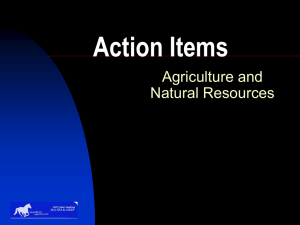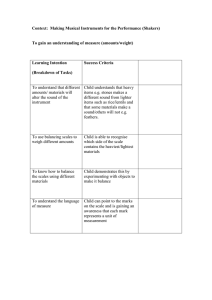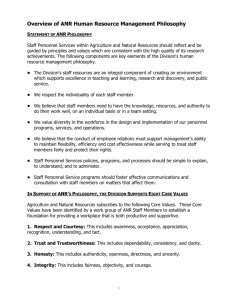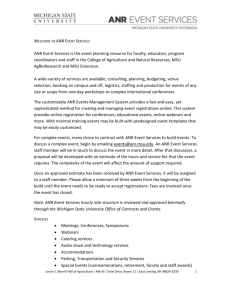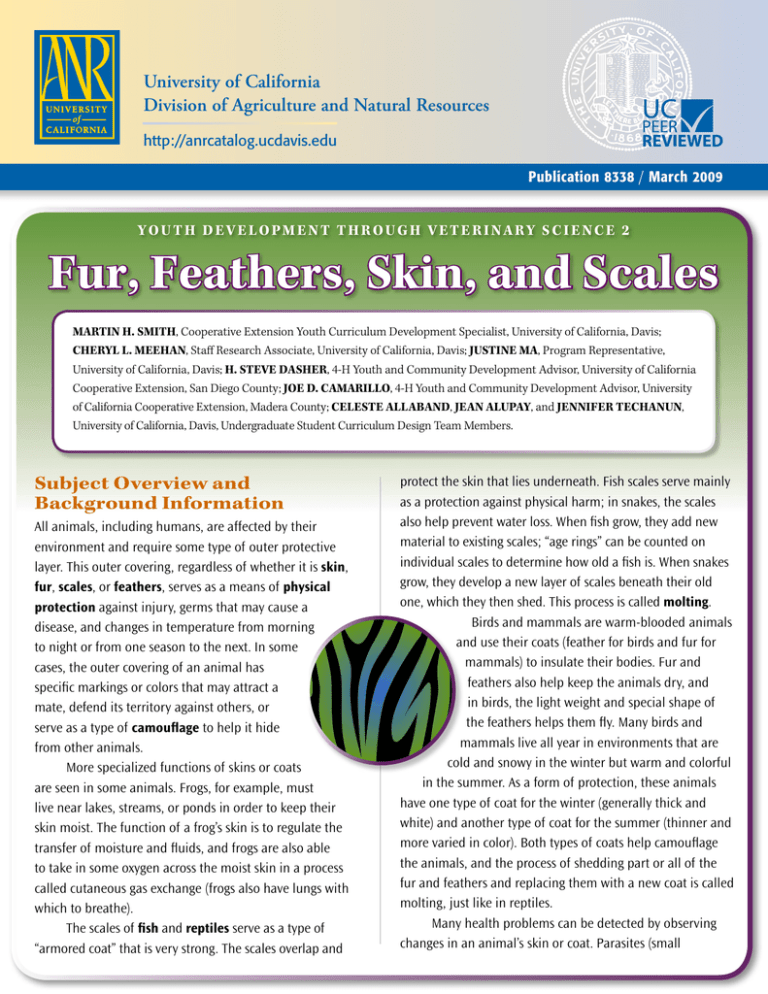
University of California
Division of Agriculture and Natural Resources
http://anrcatalog.ucdavis.edu
Publication 8338 / March 2009
Y outh D evelo pment throu g h V eterinary S cience 2
Fur, Feathers, Skin, and Scales
MARTIN H. SMITH, Cooperative Extension Youth Curriculum Development Specialist, University of California, Davis;
CHERYL L. MEEHAN, Staff Research Associate, University of California, Davis; JUSTINE MA, Program Representative,
University of California, Davis; H. STEVE DASHER, 4-H Youth and Community Development Advisor, University of California
Cooperative Extension, San Diego County; JOE D. CAMARILLO, 4-H Youth and Community Development Advisor, University
of California Cooperative Extension, Madera County; Celeste Allaband, Jean Alupay, and Jennifer Techanun,
University of California, Davis, Undergraduate Student Curriculum Design Team Members.
Subject Overview and
Background Information
All animals, including humans, are affected by their
environment and require some type of outer protective
layer. This outer covering, regardless of whether it is skin,
fur, scales, or feathers, serves as a means of physical
protection against injury, germs that may cause a
disease, and changes in temperature from morning
to night or from one season to the next. In some
cases, the outer covering of an animal has
specific markings or colors that may attract a
mate, defend its territory against others, or
serve as a type of camouflage to help it hide
from other animals.
More specialized functions of skins or coats
are seen in some animals. Frogs, for example, must
live near lakes, streams, or ponds in order to keep their
skin moist. The function of a frog’s skin is to regulate the
transfer of moisture and fluids, and frogs are also able
to take in some oxygen across the moist skin in a process
called cutaneous gas exchange (frogs also have lungs with
which to breathe).
The scales of fish and reptiles serve as a type of
“armored coat” that is very strong. The scales overlap and
protect the skin that lies underneath. Fish scales serve mainly
as a protection against physical harm; in snakes, the scales
also help prevent water loss. When fish grow, they add new
material to existing scales; “age rings” can be counted on
individual scales to determine how old a fish is. When snakes
grow, they develop a new layer of scales beneath their old
one, which they then shed. This process is called molting.
Birds and mammals are warm-blooded animals
and use their coats (feather for birds and fur for
mammals) to insulate their bodies. Fur and
feathers also help keep the animals dry, and
in birds, the light weight and special shape of
the feathers helps them fly. Many birds and
mammals live all year in environments that are
cold and snowy in the winter but warm and colorful
in the summer. As a form of protection, these animals
have one type of coat for the winter (generally thick and
white) and another type of coat for the summer (thinner and
more varied in color). Both types of coats help camouflage
the animals, and the process of shedding part or all of the
fur and feathers and replacing them with a new coat is called
molting, just like in reptiles.
Many health problems can be detected by observing
changes in an animal’s skin or coat. Parasites (small
Y o u t h D e v e l o p m e n t t h r o u g h V e t e r i n a r y S c i e n c e 2 • ANR 8 3 3 8 . . . . . . . . . . . . . . . . . . . . . . . . . F u r , F e a t h e r s , S k i n , a n d S c a l e s organisms that live on animals) such as fleas or mites can
cause fur or feathers to fall out or skin to become reddened,
patchy, or irritated. In snakes, living in an unsanitary
environment can lead blisters to form on the skin of the
underbelly, which can be life-threatening if not treated
properly. Parrots and other birds may lose their feathers if
they are infected with a virus or are overstressed. In goats,
bacterial infection of the skin can cause lesions and loss of
fur. In many species, an allergic reaction is characterized by
itchy skin, loss of fur or feathers, and swelling. Whenever a
caretaker notices these or other changes associated with an
animal’s skin or coat, it is important to consider consulting
a veterinarian.
Activity Concepts and Vocabulary
• Camouflage (kam-uh-flahzh): Methods animals use
that allow them to blend into the environment to avoid
being seen by predators or prey.
• Molting: The process of shedding and replacing parts
or all of one’s coat or outer covering (i.e., feathers,
cuticle, skin).
• Physical protection: Preserving the body from injury
or harm.
Life Skills
• Head: critical thinking, learning to learn, wise used of
resources
• Heart: cooperation, communication
• Hands: teamwork, self-motivation
Subject Links
Science and Language Arts
State Content Standards
Science
Language Arts
• Grade 3
Listening and Speaking Strategies: 1.8
• Grade 4
Listening and Speaking Strategies: 1.7, 1.8
• Grade 5
Listening and Speaking Strategies: 1.5
• Grade 6
Listening and Speaking Strategies: 1.5
Purpose of Activity
The purpose of this activity is to have the youth explore
different coverings that animals have and the reasons why
they have them (e.g., human: skin and clothing; birds:
feathers; bear: fur; reptiles: scales).
Activity
Fur, Feathers, Skin,
and Scales
Overview of the Activity
This activity is divided into Part A and Part B. In
Part A youth will observe the skin on different
parts of their body, comparing the similarities
and differences between skin in different areas.
They will also have a chance to observe different types of
fabric and record the similarities and differences they find.
In Part B youth will be given several pictures of
different animals and will make observations about them.
Based on their observations, they will make inferences
regarding the environment in which each animal lives and
how it is able to survive in that environment.
Time Required
• Grade 4
Investigation and Experimentation: 6a, 6c, 6f
Approximately 75 minutes
• Grade 5
Investigation and Experimentation: 6h
Suggested Groupings
• Grade 6
Investigation and Experimentation: 7c
2
Pairs or small groups
Y o u t h D e v e l o p m e n t t h r o u g h V e t e r i n a r y S c i e n c e 2 • ANR 8 3 3 8 . . . . . . . . . . . . . . . . . . . . . . . . . F u r , F e a t h e r s , S k i n , a n d S c a l e s Materials Needed for Each Pair
(*Materials provided in the curriculum )
• Magnifying glass
• Fabric samples: Different colors, patterns, materials,
and textures
Volunteer Tip: Free samples can be obtained from
many fabric stores.
• Flip chart paper
• Markers or other writing utensils
• *Animal coat photographs
• *Molting animal photographs
Getting Ready
• Divide youth into pairs or small groups.
• Make one color copy of the animal coat photographs
and molting animal photographs per group.
• Provide one magnifying glass per group.
• Provide each group with a piece of flip chart paper and
colored markers.
Volunteer Tip: On the day of the activity, ask the
youth to dress for “Wacky Clothes Day.” Encourage
them to wear different colors, patterns, textures, and
seasonal clothing.
Opening Questions
Ask the youth to respond to each question below by sharing
their ideas verbally and/or by recording them on the flip
chart paper provided.
1. What do you know about your skin? What purposes
do you think skin has?
2. Describe what you know about different types of
clothing. What purposes do you think clothing
serves for humans?
3. What do you know about animal coats or
coverings? What do you think some of the functions
of coats or coverings are?
4. What are some things that skin, clothes, and animal
coats or coverings have in common? What are some
things about them that are different?
3
Procedure (Experiencing) A
1. Ask the youth to examine the skin on the outer and
inner sides of their arms. Ask the youth to record
their observations and make comparisons between
these two locations.
2. Next, have the youth compare the skin on their
palms and the backs of their hands. Ask the youth
to record their observations and make comparisons
with their observations from Step 1.
3. If available, provide the youth with magnifying
glasses to observe their hands and arms in greater
detail. Have them make comparisons with the
observations they made in Step 2. Ask the youth to
record their observations and comparisons on the
flip chart paper provided.
4. Have the youth look at their clothing or fabric
swatches. Encourage them to look for similarities
and differences (e.g., colors, textures, and
thickness). For each type of fabric, ask the youth
to make an inference regarding the purpose an
article of clothing made from that fabric might
serve. Ask the youth to record their observations,
comparisons, and inferences on the flip chart paper
provided.
Procedure (Experiencing) B
1. Have the youth view the animal coat photographs
provided. Using the flip chart paper and markers,
ask them to record their observations and
comparisons on the paper provided.
2. Based on their observations, ask the youth to
predict where they think the animals might live
based on the animals’ coverings, as well as how
their coverings might help them survive. Ask them
to record their thoughts and the reasons behind
their predictions.
Y o u t h D e v e l o p m e n t t h r o u g h V e t e r i n a r y S c i e n c e 2 • ANR 8 3 3 8 . . . . . . . . . . . . . . . . . . . . . . . . . F u r , F e a t h e r s , S k i n , a n d S c a l e s Sharing, Processing, and
Generalizing
Follow the lines of thinking developed by the youth as they
share and compare their thoughts and observations. If
necessary, use more targeted questions as prompts to get to
particular points, such as:
1. What are some reasons you think we have more
hair on the outside of our arms and hands than on
the inside? What do you think the purpose(s) of this
hair might be? Please explain your thoughts and
ideas.
2. How do you think animals’ coverings—bear’s
fur, bird feathers, fish scales, humans’ skin and
clothing—might help them survive where they
live? Please explain and provide examples.
Concept and Term Discovery/
Introduction
Volunteers need to ensure that the concepts of physical
protection, molting, and camouflage have been
introduced or discovered by the youth.
• Note: The goal is to have the youth discover the
concepts and terms on their own. It helps if they can
define terms and concepts using their own words.
4
Concept Application
1. Some animals live in environments that have very
distinct seasons. It might become very hot in the
summer and very cold in the winter. Look at the
pictures of the cardinal (bird) and reindeer in the
molting animal photographs. Notice the differences
in their coats and explain why these animals might
need to change their coats (a process known as
molting).
2. Ask the youth to explore their neighborhood or
local park. Ask them to look at the animals in
that environment and notice the different animal
coverings.
3. If the youth have pets of their own, ask them to
look closely at their pet’s coat or outer covering.
Ask them to notice details, such as color and
texture.
References
Foster, A., and C. Foll. 2003. BSAVA manual of small animal
dermatology. Gloucester, UK: British Small Animal
Veterinary Association.
Hislop, T., J. Cook, and E. Morgan. 2002. Animal coverings.
Utah Education Network Web site, http://www.uen.
org/Lessonplan/preview.cgi?LPid=629.
MSN Encarta. Snake (reptile). MSN Encarta Web site,
http://encarta.msn.com/encyclopedia_761578341/
Snake_(reptile).html.
Y o u t h D e v e l o p m e n t t h r o u g h V e t e r i n a r y S c i e n c e 2 • ANR 8 3 3 8 . . . . . . . . . . . . . . . . . . . . . . . . . F u r , F e a t h e r s , S k i n , a n d S c a l e s Reptile Scales
Andre Magill
http://www.flickr.com/photos/amagill/2963840608/
5
Y o u t h D e v e l o p m e n t t h r o u g h V e t e r i n a r y S c i e n c e 2 • ANR 8 3 3 8 . . . . . . . . . . . . . . . . . . . . . . . . . F u r , F e a t h e r s , S k i n , a n d S c a l e s Reptile Scales
Jenny Downing
http://www.flickr.com/photos/jenny-pics/2715258785/
6
Y o u t h D e v e l o p m e n t t h r o u g h V e t e r i n a r y S c i e n c e 2 • ANR 8 3 3 8 . . . . . . . . . . . . . . . . . . . . . . . . . F u r , F e a t h e r s , S k i n , a n d S c a l e s Reptile Scales
Scot Campbell
http://www.flickr.com/photos/randomurl/538907018/
7
Y o u t h D e v e l o p m e n t t h r o u g h V e t e r i n a r y S c i e n c e 2 • ANR 8 3 3 8 . . . . . . . . . . . . . . . . . . . . . . . . . F u r , F e a t h e r s , S k i n , a n d S c a l e s Fish Scales
Corrie Barklimore
http://www.flickr.com/photos/corrieb/2855396217/
8
Y o u t h D e v e l o p m e n t t h r o u g h V e t e r i n a r y S c i e n c e 2 • ANR 8 3 3 8 . . . . . . . . . . . . . . . . . . . . . . . . . F u r , F e a t h e r s , S k i n , a n d S c a l e s Fish Scales
Alexandra Lee
http://www.flickr.com/photos/alexandralee/163379800/
9
Y o u t h D e v e l o p m e n t t h r o u g h V e t e r i n a r y S c i e n c e 2 • ANR 8 3 3 8 . . . . . . . . . . . . . . . . . . . . . . . . . F u r , F e a t h e r s , S k i n , a n d S c a l e s Bird Feathers
Rita Ballantyne
http://www.publicdomainpictures.net/view-image.php?image=1037&large=1
10
Y o u t h D e v e l o p m e n t t h r o u g h V e t e r i n a r y S c i e n c e 2 • ANR 8 3 3 8 . . . . . . . . . . . . . . . . . . . . . . . . . F u r , F e a t h e r s , S k i n , a n d S c a l e s Bird Feathers
Sherri Hogue
http://www.publicdomainpictures.net/view-image.php?image=823
11
Y o u t h D e v e l o p m e n t t h r o u g h V e t e r i n a r y S c i e n c e 2 • ANR 8 3 3 8 . . . . . . . . . . . . . . . . . . . . . . . . . F u r , F e a t h e r s , S k i n , a n d S c a l e s Bird Feathers
Nisheedhi Adukuri
http://www.publicdomainpictures.net/view-image.php?image=761v
12
Y o u t h D e v e l o p m e n t t h r o u g h V e t e r i n a r y S c i e n c e 2 • ANR 8 3 3 8 . . . . . . . . . . . . . . . . . . . . . . . . . F u r , F e a t h e r s , S k i n , a n d S c a l e s Bird Feathers
Petr Kratochvil
http://www.publicdomainpictures.net/view-image.php?image=84
13
Y o u t h D e v e l o p m e n t t h r o u g h V e t e r i n a r y S c i e n c e 2 • ANR 8 3 3 8 . . . . . . . . . . . . . . . . . . . . . . . . . F u r , F e a t h e r s , S k i n , a n d S c a l e s Mammal Fur
Petr Kratochvil
http://www.publicdomainpictures.net/view-image.php?image=1184
14
Y o u t h D e v e l o p m e n t t h r o u g h V e t e r i n a r y S c i e n c e 2 • ANR 8 3 3 8 . . . . . . . . . . . . . . . . . . . . . . . . . F u r , F e a t h e r s , S k i n , a n d S c a l e s Mammal Fur
Geoff Doggett
http://www.publicdomainpictures.net/view-image.php?image=536
15
Y o u t h D e v e l o p m e n t t h r o u g h V e t e r i n a r y S c i e n c e 2 • ANR 8 3 3 8 . . . . . . . . . . . . . . . . . . . . . . . . . F u r , F e a t h e r s , S k i n , a n d S c a l e s Mammal Fur
Petr Kratochvil
http://www.publicdomainpictures.net/view-image.php?image=124&large=1
16
Y o u t h D e v e l o p m e n t t h r o u g h V e t e r i n a r y S c i e n c e 2 • ANR 8 3 3 8 . . . . . . . . . . . . . . . . . . . . . . . . . F u r , F e a t h e r s , S k i n , a n d S c a l e s Mammal Fur
Petr Kratochvil
http://www.publicdomainpictures.net/view-image.php?image=208
17
Y o u t h D e v e l o p m e n t t h r o u g h V e t e r i n a r y S c i e n c e 2 • ANR 8 3 3 8 . . . . . . . . . . . . . . . . . . . . . . . . . F u r , F e a t h e r s , S k i n , a n d S c a l e s Molting Lizard
Melvin Baker
http://www.flickr.com/photos/i_level_news/456755318/
18
Y o u t h D e v e l o p m e n t t h r o u g h V e t e r i n a r y S c i e n c e 2 • ANR 8 3 3 8 . . . . . . . . . . . . . . . . . . . . . . . . . F u r , F e a t h e r s , S k i n , a n d S c a l e s Molting Cardinal
Ellen Davis
http://www.flickr.com/photos/ellen3davis/1342154140/
19
Y o u t h D e v e l o p m e n t t h r o u g h V e t e r i n a r y S c i e n c e 2 • ANR 8 3 3 8 . . . . . . . . . . . . . . . . . . . . . . . . . F u r , F e a t h e r s , S k i n , a n d S c a l e s Molting Reindeer
Mats Lindh
http://www.flickr.com/photos/fiskfisk/2672918052/
20
Y o u t h D e v e l o p m e n t t h r o u g h V e t e r i n a r y S c i e n c e 2 • ANR 8 3 3 8 . . . . . . . . . . . . . . . . . . . . . . . . . F u r , F e a t h e r s , S k i n , a n d S c a l e s APPENDIX
For Further Information
The activity in this curriculum is designed around inquiry
and experiential learning. Inquiry is a learner-centered
approach in which individuals are problem solvers
investigating questions through active engagement,
observing and manipulating objects and phenomena, and
acquiring or discovering knowledge. Experiential learning
(EL) is a foundational educational strategy used in 4-H. In
it, the learner has an experience phase of engagement in
an activity, a reflection phase in which observations and
reactions are shared and discussed, and an application
phase in which new knowledge and skills are applied
to a real-life setting. In 4-H, an EL model that uses a
5-step learning cycle is most commonly used. These five
steps—Exploration, Sharing, Processing, Generalizing, and
Application—are part of a recurring process that helps
build learner understanding over time.
Experiential Learning
Experience
apply
21
share
To order or obtain ANR publications and other products, visit the ANR
Communication Services online catalog at http://anrcatalog.ucdavis.edu or
phone 1-800-994-8849. You can also place orders by mail or FAX, or request a
printed catalog of our products from
University of California
Agriculture and Natural Resources
Communication Services
6701 San Pablo Avenue, 2nd Floor
Oakland, California 94608-1239
Telephone 1-800-994-8849
510-642-2431
FAX 510-643-5470
E-mail: danrcs@ucdavis.edu
©2009 The Regents of the University of California
Agriculture and Natural Resources
All rights reserved.
No part of this publication may be reproduced, stored in a retrieval system,
or transmitted, in any form or by any means, electronic, mechanical,
photocopying, recording, or otherwise, without the written permission of the
publisher and the authors.
Publication 8338
ISBN-13: 978-1-60107-583-3
The University of California prohibits discrimination or harassment of any
person on the basis of race, color, national origin, religion, sex, gender identity,
pregnancy (including childbirth, and medical conditions related to pregnancy
or childbirth), physical or mental disability, medical condition (cancer-related
or genetic characteristics), ancestry, marital status, age, sexual orientation,
citizenship, or service in the uniformed services (as defined by the Uniformed
Services Employment and Reemployment Rights Act of 1994: service in the
uniformed services includes membership, application for membership,
performance of service, application for service, or obligation for service in the
uniformed services) in any of its programs or activities.
University policy also prohibits reprisal or retaliation against any person in
any of its programs or activities for making a complaint of discrimination or
sexual harassment or for using or participating in the investigation or resolution
process of any such complaint.
generalize
process
For more information on inquiry, EL and the 5-step learning
cycle, please visit the University of California’s Science,
Technology, Environmental Literacy Workgroup’s Experiential
Learning Web site, http://www.experientiallearning.ucdavis
.edu/default.shtml.
University policy is intended to be consistent with the provisions of applicable
State and Federal laws.
Inquiries regarding the University’s nondiscrimination policies may be directed
to the Affirmative Action/Equal Opportunity Director, University of California,
Agriculture and Natural Resources, 1111 Franklin Street, 6th Floor, Oakland, CA
94607, (510) 987-0096. For information about ordering this publication,
telephone 1-800-994-8849. For assistance in downloading this publication,
telephone 530-754-3927.
An electronic copy of this publication can be found at the ANR Communication
Services catalog Web site, http://anrcatalog.ucdavis.edu.
This publication has been anonymously peer reviewed for technical
accuracy by University of California scientists and other qualified professionals.
This review process was managed by the ANR Associate Editor for Human and
Community—Youth Development.
pr-3/09-SB/RW

